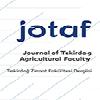Managing genetic variation to conserve genetic diversity in goats and sheep
kendileme depresyonu, mutasyon, keçi, koyun, yapay seleksiyon, üreme programları, koruma, genetik çeşitlilik, keçi ırkları, koyun ırkları, populasyon genetiği, performans özellikleri, kendileme, kalıtsallık, genetik farklılık, döllenme gücü, soyu tükenmekte olan ırklar, genetik kaynaklar, hayvan ıslahı
Koyun ve keçilerdeki genetik çeşitliliği korumak için genetik varyasyonun yönetimi
inbreeding depression, mutations, goats, sheep, artificial selection, breeding programmes, conservation, genetic variation, goat breeds, sheep breeds, population genetics, performance traits, inbreeding, heritability, genetic diversity, fecundity, endangered breeds, genetic resources, animal breeding,
___
- Anonymous, 1998. Secondary Guidelines: Management of small populations at risk. Food and Agriculture Organization of the United Nations, Rome, Italy, 219 p.
- Anonymous, 2008. Food and Agriculture Organization of the United Nations, Rome, Italy, accessed July 2008.
- Anonymous, 2009. http://www.fao.org/dad-is/ accessed 23 Feb. 2009 Barillet, F., Boichard, D., 1987. Studies on dairy production of milking ewes. I. Estimates of genetic parameters for total milk composition and yield. Génét. Sél. Evol. 19, 459-474.
- Bosso, N.A., Cissé, M.F., van der Waaij, E.H., Fall, A., van Arendonk, J.A.M., 2007. Genetic and phenotypic parameter estimates of body weight in West African Dwarf goat and Djallanké sheep. Small Rumin. Res. 67, 271-278.
- Crow, J.F., 1954. Breeding structure of populations. II. Effective population number. In: Kempthorne, O., Bancroft, T.A., Gowen, J.W., Lush, J.L., (Eds.), Statistics and Mathematics in Biology. Iowa State College Press, Ames, Iowa, USA, pp. 543-556.
- Crow, J.F., Morton, N.E., 1955. Measurement of gene frequency drift in small populations. Evolution 9, 202-214. .
- Fisher, R.A., 1930. The genetic theory of natural selection. Clarendon Press, Oxford, UK.
- Galal, S. 2005. Biodiversity in goats. Small Rumin. Res. 60, 75-81.
- Gowe, R.S., Robertson, A., Latter, B.D.H., 1959. Environment and poultry breeding problems. 5. The design of poultry control strains. Poult. Sci. 38, 462-471.
- Hill, W. G., 1972. Estimation of genetic change. I. General theory and design of control populations. Anim. Breed. Abstr. 40, 1-15.
- Kominakis, A., Rogdakis, E., Vasiloudis, Ch., Liaskos, O., 2000. Genetic and environmental sources of variation of milk yield of Skopelos dairy goats. Small Rumin. Res. 36, 1-5.
- Neser, F.W.C., Erasmus, G.J., van Wyk, J.B., 2001. Genetic parameter estimates for pre-weaning weight traits in Dorper sheep. Small Rumin. Res. 40, 197-202.
- Ozcan, M., Ekiz, B., Yilmaz, A., Ceyhan, A., 2005. Genetic parameter estimates for lamb growth traits and greasy fleece weight at first shearing in Turkish Merino sheep. Small Rumin. Res. 56, 215-222.
- Scherf, B. D., (Editor) 2000. World watch list of domestic animal diversity. Third Edition, Food and Agriculture Organization of the United Nations, Rome, Italy, 726 pp.
- Schoeman, S.J., Els, J.F., van Niekerk, M.M., 1997. Variance components of early growth traits in the Boer goat. Small Rumin. Res. 26, 15-20.
- Shrestha, J. N. B., Peters, H. F., Heaney, D. P., Van Vleck, L. D., 1996. Genetic trends over 20 years of selection in the three synthetic Arcotts, Suffolk and Finnish Landrace sheep breeds. 1. Early growth traits. Can. J. Anim. Sci. 76, 1-6.
- Shrestha, J.N.B., Galal, S., Mariante, A. da S., Kotze, A., Delgardo, J.V., Devendra, C., 2008. Impact of globalization on livestock and poultry genetic resources in the world. Proc. Seventh Global Conference on Conservation of Domestic Animal Genetic Resources, National Institute of Animal Husbandry and Rare Breeds International, Hanoi, Vietnam.
- Smith, C., 1977. The use of frozen semen and embryos to measure genetic trends in farm livestock. Z. Tierzucht. Zuchtungsbiol. 94, 119-130.
- Smith, C., 1984. Genetics aspects of conservation in farm livestock. Livest. Prod. Sci. 11, 37-48.
- Taddeo, H.R., Allain, D., Mueller, J., Rochambeau, H., Manfredi, E., 1998. Genetic parameter estimates of production traits of Angora goats in Argentina. Small Rumin. Res. 28, 217-223.
- Wright, S., 1931. Evolution in Mendelian populations. Genetics 16, 97-159.
- Wright, S., 1939. Statistical genetics in relation to evolution. Exposes de Biometrie et de Statistique Biologique, Hermann and Cie, Paris, No. 802, 63pp.
- Wright, S., 1945. The differential equation of the distribution of gene frequencies. Proc. Nat. Acad. Sci. 31, 382-389.
- ISSN: 1302-7050
- Yayın Aralığı: 3
- Başlangıç: 2004
- Yayıncı: Namık Kemal Üniv. Tekirdağ Ziraat Fak.
Aerobik stabilite süresince paket silajlarinda renk değişimi
Effects of vegetable oils on the quality parameters of red pepper during storage
L. A. İNANÇ, M. DEMİRCİ, M. ALPASLAN
Tekirdağ piyasasında satılan bazı baharatların mikrobiyolojik özellikleri
Bazı Türkiye yerli ırk Koyunlarında Entansif besi süresince vücut ölçülerinin değişimi
A. KARABACAK, S. BOZTEPE, B. DAĞ, O. ŞAHİN
Çocuk oyun alanlarının dağılımı ve kullanım yeterliliği: Tekirdağ örneği
Managing genetic variation to conserve genetic diversity in goats and sheep
